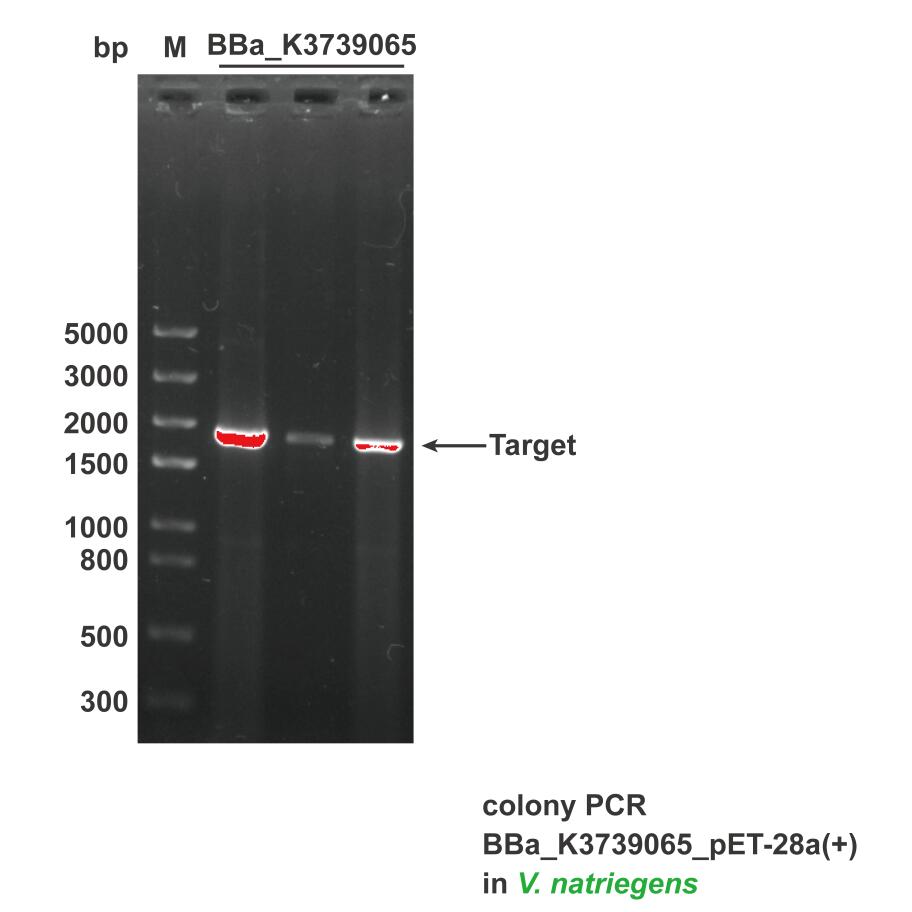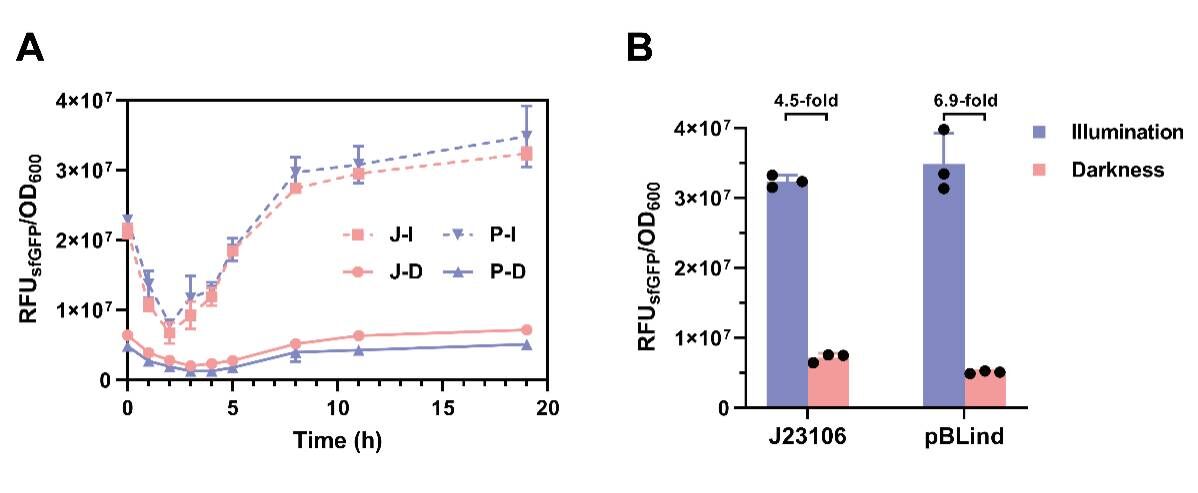Part:BBa_K3739065
J23106-B0034-K2332004-K2332002-B0030-GFP
pBLind system optimized
Biology
EL222
EL222 is a photosensitive protein composed of an N-terminal light-oxygen-voltage (LOV) domain and a C-terminal helix-turn-helix (HTH) DNA-binding domain characteristic of LuxR-type DNA-binding proteins. In the dark, the LOV domain of EL222 represses its HTH domain. Illuminated by blue light (450nm), the LOV-HTH interaction is released, allowing EL222 to dimerize and bind to DNA.
pBLind
It is a modified luxI promoter. The lux box (LuxR and 3-oxo-C6-HSL complex binding region) of this promoter is replaced by the 18-bp EL222 binding region. Upon illumination with the blue light, EL222 dimer can presumably overlap the −35 region of the luxI promoter, thereby recruiting RNAP and activating transcription.
Fig.1. Gene circuit illustration for pBLind promoter system (BBa_K3739065).
Usage and Design
This circuit and BBa_K3739064 were designed to test GFP expression with the light-induced promoter pBLind. By comparing the fluorescence intensity/OD600 of induced and non-induced bacteria, we managed to characterize the function of the light-regulated module.
In the original design of pBLind promoter system, EL222 was expressed by a strong promoter in the Anderson family, such as BBa_J23119 and BBa_J23106. Therefore, we can increase the sensitivity of this light-regulated module and lower the leakage of expression by using a weaker promoter or even an induced promoter.
With this intention, we replace the promoter in BBa_J23106 with pBLind, choose sfGFP as a reporter gene and construct the BBa_K3739064. By decreasing the leakage of EL222’s expression, we hope that the modified light-regulated system can be firmly restrained in dark circumstances while experiencing positive feedback induced by blue light.
Characterization
1. Agarose Gel Electrophoresis
After constructing the part on the expression vector pSB1C3, the plasmid was transferred into E. coli BL21(DE3), then the positive colony were selected by chloramphenicol and verified by colony PCR and sequencing.
Meanwhile, we also constructed this part on the expression vector pET-28a(+), then transferred the plasmid into Vibrio natriegens. The constructed plasmid was transformed into Vibrio natriegens, the positive colony was selected by kanamycin and verified by colony PCR and sequencing.
Fig.2. The result of colony PCR. Plasmid pET28a(+).
2. Growth curve measurement
First, we characterized the leakage of the original promoter system and the modified one by measuring the fluorescence/OD600 of J23106-EL222-pBLind-sfGFP and pBLind-EL222-pBLind-sfGFP under the strictly shadowed situation.
As shown in Fig. 3A, pBLind promoter has successfully restrained the expression leakage of sfGFP. However, to ensure the light-induced system can still function when exposed to blue light, we conducted another experiment characterizing the photoresponse of J23106-EL222-pBLind-sfGFP and pBLind-EL222-pBLind-sfGFP under consistent blue light exposure.
From the curve, we can see the fluorescence/OD600 of the modified group has responded parallelly to the original group when induced by blue light, implying a similar expression under the blue light exposure. However, as the expression leakage of the modified system is lower than the original system, it shows a more sensitive response to light induction.
The result is shown below:
Fig.3. Demonstration of J23106-EL222-pBLind-GFP and pBLind-EL222-pBLind-GFP in E.coli. (A) Comparison of the expression leakage and photoresponse of J23106 promoter and pBLind promoter by measuring the fluorescence/OD600 in the growth curve. (B) Comparison of the fluorescence intensity at 19 hours after inoculation.
Fig.4. Demonstration of J23106-EL222-pBLind-GFP and pBLind-EL222-pBLind-GFP in V.natriegens. (A) Comparison of the expression leakage and photoresponse of J23106 promoter and pBLind promoter by measuring the fluorescence/ OD600 in the growth curve. J-I: Illuminated J23106-EL222-pBLind-GFP. J-D: Dark J23106-EL222-pBLind-GFP. P-I: Illuminated pBLind-EL222-pBLind-GFP. P-D: Dark pBLind-EL222-pBLind-GFP. (B) Comparison of the fluorescence intensity at 19 hours after inoculation.
Under the same light intensity, the modified system can respond more intensely than the original system. That is to say: the modified pBLind promoter system has a higher sensitivity towards light compared to the original system while showing a lower expression leakage under a strictly shadowed position, which means that our improvement works as expected.
Protocol: 1. Inoculate 200 μL bacteria glycerol stock into 10 mL LB liquid medium with 0.1 mg/mL chloramphenicol, 37 °C, 200 rpm overnight. 2. Inoculate 200 μL bacteria culture of experimental (blue light-induced) and control group (dark) into each group of flasks, shake the flasks and immediately take 200 μL out for detection. 3. Culture at 37 °C, 200 rpm for 20 hours, take 200 μL of culture at 1 h, 2 h, 3 h, 4 h, 5 h, 8 h, 11 h, 19 h for detection of fluorescent intensity and OD600.
Sequence and Features
- 10COMPATIBLE WITH RFC[10]
- 12INCOMPATIBLE WITH RFC[12]Illegal NheI site found at 7
Illegal NheI site found at 30 - 21COMPATIBLE WITH RFC[21]
- 23COMPATIBLE WITH RFC[23]
- 25INCOMPATIBLE WITH RFC[25]Illegal NgoMIV site found at 142
Illegal AgeI site found at 367 - 1000COMPATIBLE WITH RFC[1000]
| None |




